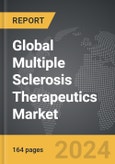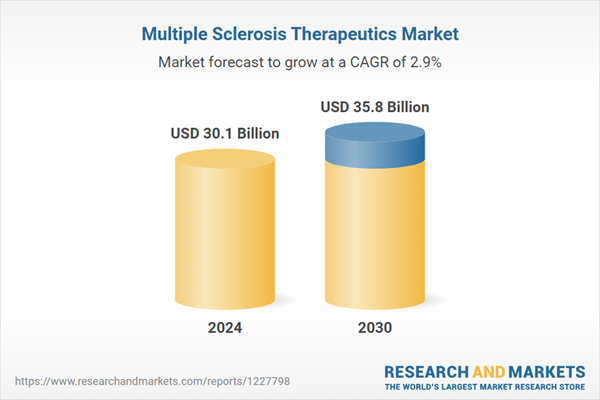Global Multiple Sclerosis Therapeutics Market - Key Trends & Drivers Summarized
Why Is the Treatment Landscape for Multiple Sclerosis Undergoing Rapid Evolution?
Multiple sclerosis (MS), a chronic, inflammatory, demyelinating disorder of the central nervous system, has historically lacked curative options, but the therapeutic landscape is rapidly evolving. The emergence of targeted immunomodulatory and immunosuppressive agents has transformed MS from a debilitating disease with poor prognosis into a manageable condition for many patients. The development pipeline is expanding beyond traditional disease-modifying therapies (DMTs) into monoclonal antibodies, sphingosine-1-phosphate (S1P) receptor modulators, B-cell depleting agents, and gene-based interventions.The classification of MS into subtypes-relapsing-remitting MS (RRMS), primary progressive MS (PPMS), and secondary progressive MS (SPMS)-has led to more nuanced treatment regimens that consider disease stage, activity level, and patient-specific immune responses. Monoclonal antibodies such as ocrelizumab and ofatumumab have shown success in slowing disease progression, especially in PPMS where earlier treatments were largely ineffective. Oral agents like fingolimod and dimethyl fumarate offer convenience, leading to improved adherence in long-term disease management.
What Scientific and Technological Breakthroughs Are Redefining MS Therapy?
Scientific advancements in the understanding of MS pathogenesis, particularly the role of B-cells, cytokine signaling, and gut-brain axis interactions, are unlocking new therapeutic strategies. The focus has shifted from non-specific immunosuppression to selective immune modulation, enabling better efficacy with fewer adverse events. Anti-CD20 therapies are gaining ground due to their ability to reduce relapse rates and lesion formation without compromising long-term immune surveillance.Next-generation therapies are exploring remyelination and neuroprotection. Experimental agents such as clemastine fumarate and opicinumab are being investigated for their potential to promote oligodendrocyte regeneration and axonal repair. mRNA-based therapies and gene-editing technologies are also in preclinical stages, targeting the correction of immune dysfunction at the molecular level.
Biomarker development is aiding in personalized therapy selection and early diagnosis. MRI-based lesion tracking, serum neurofilament light chain (NfL) levels, and HLA genotyping are becoming tools for therapeutic monitoring and stratified treatment planning. Digital health platforms are emerging to support remote patient monitoring, relapse detection, and medication adherence through mobile apps and wearable devices-improving clinical outcomes and enabling real-world evidence generation.
Which Patient Demographics, Drug Classes, and Regional Dynamics Are Driving Demand?
The prevalence of MS is highest in North America and Europe, with increasing diagnosis rates in Asia-Pacific and Latin America due to improved awareness and diagnostic capabilities. RRMS remains the most commonly diagnosed form, but the share of PPMS and SPMS is growing as diagnostic imaging and biomarker usage increase. Younger adults (aged 20-40), particularly women, constitute the majority of new diagnoses, making long-term therapy adherence and safety profiles key market considerations.Oral DMTs are the most widely used therapies in terms of volume, but monoclonal antibodies account for the largest market share by revenue due to higher pricing and hospital-based administration models. B-cell therapies, S1P receptor modulators, and integrin inhibitors are the leading classes shaping current treatment regimens. Meanwhile, adjunct therapies including corticosteroids, muscle relaxants, and antidepressants continue to support symptom relief, especially in progressive disease cases.
The U.S. leads global MS therapeutic sales due to high healthcare expenditure, favorable reimbursement, and faster regulatory approvals. Europe, particularly Germany, France, and the U.K., follows closely with strong uptake of biologics. Emerging markets in Asia-Pacific are becoming attractive for generic DMTs and biosimilars as health systems expand neurological care infrastructure. Patient advocacy organizations are also influencing treatment access, pricing policies, and clinical trial participation globally.
What Is Fueling Growth in the Global Multiple Sclerosis Therapeutics Market?
The growth in the global multiple sclerosis therapeutics market is driven by several factors, including increasing disease prevalence, improved diagnostic practices, and a robust innovation pipeline targeting multiple pathogenic pathways. The diversification of therapeutic options, from broad immunosuppressants to highly specific monoclonal antibodies and oral agents, is allowing physicians to tailor treatments based on individual patient profiles, disease subtypes, and biomarker expression.Advances in molecular biology, immunology, and neurodegeneration research are expanding the horizon for next-generation therapies focused on neurorepair and long-term remission. Coupled with improvements in clinical trial design, regulatory support for orphan and fast-track designations, and a growing investment landscape, the pace of drug development in MS is accelerating. The transition toward value-based care and real-world evidence is encouraging the development of digital tools and companion diagnostics that enhance treatment efficacy and patient engagement.
Growing awareness, improved access to neurologists, and rising healthcare expenditure are driving market expansion in both developed and emerging economies. Biosimilars, extended-release formulations, and alternative administration routes are reducing barriers to entry in cost-sensitive markets. As personalized medicine becomes central to chronic disease management, the multiple sclerosis therapeutics market is poised for sustained growth, with new entrants and innovative mechanisms continuing to reshape the treatment paradigm.
Scope of the Report
The report analyzes the Multiple Sclerosis Therapeutics market, presented in terms of market value (USD). The analysis covers the key segments and geographic regions outlined below:- Segments: Drug Type (Large-molecule Drugs, Small-molecule Drugs); Administration Route (Oral Administration Route, Injectable Administration Route, Other Administration Routes).
- Geographic Regions/Countries: World; United States; Canada; Japan; China; Europe (France; Germany; Italy; United Kingdom; Spain; Russia; and Rest of Europe); Asia-Pacific (Australia; India; South Korea; and Rest of Asia-Pacific); Latin America (Argentina; Brazil; Mexico; and Rest of Latin America); Middle East (Iran; Israel; Saudi Arabia; United Arab Emirates; and Rest of Middle East); and Africa.
Key Insights:
- Market Growth: Understand the significant growth trajectory of the Large-molecule Drugs segment, which is expected to reach US$23.2 Billion by 2030 with a CAGR of a 3.6%. The Small-molecule Drugs segment is also set to grow at 1.7% CAGR over the analysis period.
- Regional Analysis: Gain insights into the U.S. market, valued at $8.2 Billion in 2024, and China, forecasted to grow at an impressive 5.7% CAGR to reach $7.0 Billion by 2030. Discover growth trends in other key regions, including Japan, Canada, Germany, and the Asia-Pacific.
Why You Should Buy This Report:
- Detailed Market Analysis: Access a thorough analysis of the Global Multiple Sclerosis Therapeutics Market, covering all major geographic regions and market segments.
- Competitive Insights: Get an overview of the competitive landscape, including the market presence of major players across different geographies.
- Future Trends and Drivers: Understand the key trends and drivers shaping the future of the Global Multiple Sclerosis Therapeutics Market.
- Actionable Insights: Benefit from actionable insights that can help you identify new revenue opportunities and make strategic business decisions.
Key Questions Answered:
- How is the Global Multiple Sclerosis Therapeutics Market expected to evolve by 2030?
- What are the main drivers and restraints affecting the market?
- Which market segments will grow the most over the forecast period?
- How will market shares for different regions and segments change by 2030?
- Who are the leading players in the market, and what are their prospects?
Report Features:
- Comprehensive Market Data: Independent analysis of annual sales and market forecasts in US$ Million from 2024 to 2030.
- In-Depth Regional Analysis: Detailed insights into key markets, including the U.S., China, Japan, Canada, Europe, Asia-Pacific, Latin America, Middle East, and Africa.
- Company Profiles: Coverage of players such as AbbVie Inc., Actelion Pharmaceuticals Ltd (Johnson & Johnson), Acorda Therapeutics Inc., Adamas Pharmaceuticals Inc., Biogen Inc. and more.
- Complimentary Updates: Receive free report updates for one year to keep you informed of the latest market developments.
Some of the 34 companies featured in this Multiple Sclerosis Therapeutics market report include:
- AbbVie Inc.
- Actelion Pharmaceuticals Ltd (Johnson & Johnson)
- Acorda Therapeutics Inc.
- Adamas Pharmaceuticals Inc.
- Biogen Inc.
- Bristol-Myers Squibb Company
- Cipla Ltd.
- Dr. Reddy's Laboratories Ltd.
- EMD Serono (Merck KGaA)
- Evotec SE
- Glenmark Pharmaceuticals Ltd.
- GlaxoSmithKline plc (GSK)
- Hoffmann-La Roche Ltd. (Genentech)
- Johnson & Johnson
- Mapi Pharma Ltd.
- Mylan N.V. (now part of Viatris)
- Novartis AG
- Pfizer Inc.
- Sanofi S.A.
- Teva Pharmaceutical Industries Ltd.
This edition integrates the latest global trade and economic shifts into comprehensive market analysis. Key updates include:
- Tariff and Trade Impact: Insights into global tariff negotiations across 180+ countries, with analysis of supply chain turbulence, sourcing disruptions, and geographic realignment. Special focus on 2025 as a pivotal year for trade tensions, including updated perspectives on the Trump-era tariffs.
- Adjusted Forecasts and Analytics: Revised global and regional market forecasts through 2030, incorporating tariff effects, economic uncertainty, and structural changes in globalization. Includes historical analysis from 2015 to 2023.
- Strategic Market Dynamics: Evaluation of revised market prospects, regional outlooks, and key economic indicators such as population and urbanization trends.
- Innovation & Technology Trends: Latest developments in product and process innovation, emerging technologies, and key industry drivers shaping the competitive landscape.
- Competitive Intelligence: Updated global market share estimates for 2025 (E), competitive positioning of major players (Strong/Active/Niche/Trivial), and refined focus on leading global brands and core players.
- Expert Insight & Commentary: Strategic analysis from economists, trade experts, and domain specialists to contextualize market shifts and identify emerging opportunities.
Table of Contents
Companies Mentioned (Partial List)
A selection of companies mentioned in this report includes, but is not limited to:
- AbbVie Inc.
- Actelion Pharmaceuticals Ltd (Johnson & Johnson)
- Acorda Therapeutics Inc.
- Adamas Pharmaceuticals Inc.
- Biogen Inc.
- Bristol-Myers Squibb Company
- Cipla Ltd.
- Dr. Reddy's Laboratories Ltd.
- EMD Serono (Merck KGaA)
- Evotec SE
- Glenmark Pharmaceuticals Ltd.
- GlaxoSmithKline plc (GSK)
- Hoffmann-La Roche Ltd. (Genentech)
- Johnson & Johnson
- Mapi Pharma Ltd.
- Mylan N.V. (now part of Viatris)
- Novartis AG
- Pfizer Inc.
- Sanofi S.A.
- Teva Pharmaceutical Industries Ltd.
Table Information
| Report Attribute | Details |
|---|---|
| No. of Pages | 268 |
| Published | December 2025 |
| Forecast Period | 2024 - 2030 |
| Estimated Market Value ( USD | $ 30.1 Billion |
| Forecasted Market Value ( USD | $ 35.8 Billion |
| Compound Annual Growth Rate | 2.9% |
| Regions Covered | Global |









